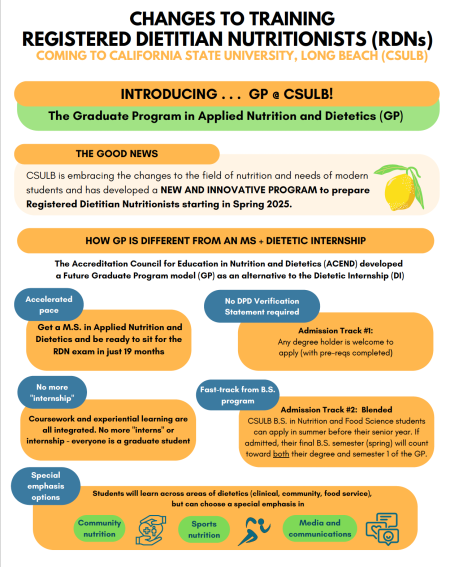GP Overview
The Graduate Program (GP) in Applied Nutrition and Dietetics is a new training model for aspiring registered dietitian nutritionists (RDNs) introduced by the Accreditation Council for Education in Nutrition and Dietetics (ACEND).
As an alternative to the standard Dietetic Internship (DI) training model, the GP is a graduate-level, competency-based dietitian nutritionist program that integrates coursework and at least 1,000 hours of experiential learning for RDN eligibility. The GP also meets the new requirements as of 2024 that require all RDNs to hold a Master's degree.

We have two application tracks:
Track 1: Traditional
Anyone who meets the Admission Requirements may apply. This track is for B.S. holders who fulfill all required prerequisite coursework (or will by the time the program starts in January).

Track 2: Blended BS-to-MS
This unique accelerated pathway for eligible CSULB students offers a fast-track route from their BS into the GP. Along with a simplified application process, students also save time and money by having 12 units double count for both the undergraduate and graduate programs. For more information, read about the Blended Track.

To train graduates for evidence-based practice as registered dietitian nutritionists equipped to solve problems, serve diverse populations with cultural humility, and advocate for good in their workplaces and communities.
To measure our program's success, we have three overarching goals across several quantifiable objectives. We collect data throughout the year to determine how we can continue improving our students' training experience. Program outcome data are available upon request.
Goal #1 – Graduates will demonstrate competence in the knowledge and skills required of entry-level registered dietitian nutritionists
- Objective 1.1 - At least 80% of students complete program requirements within 28 months (150% of the program length).
- Objective 1.2 - Of graduates who seek employment, at least 80% percent are employed in nutrition and dietetics or related fields within 12 months of graduation.
- Objective 1.3 - At least 80% percent of program graduates take the CDR credentialing exam for dietitian nutritionists within 12 months of program completion.
- Objective 1.4 - The program’s one-year pass rate (graduates who pass the registration exam within one year of first attempt) on the CDR credentialing exam for dietitian nutritionists is at least 80%.
- Objective 1.5 - At least 80% of the employers who respond to the employer survey will indicate they are satisfied with their employee's (GP graduate) preparation for entry-level practice.
- Objective 1.6 - At least 80% of graduates will rate themselves as competent for entry-level practice in the field of nutrition and dietetics.
Goal #2 – Graduates will demonstrate competence in their ability to serve culturally diverse communities.
- Objective 2.1 - At least 80% of graduates will rate themselves as competent in their ability to serve culturally and ethnically diverse clients or communities.
- Objective 2.2 - At program completion, 80% of graduates demonstrate improved scores on a cultural humility self-assessment tool, as compared with baseline pre-program assessment scores.
- Objective 2.3 – At least 80% of the employers who respond to the employer survey will rate their employees (GPAND graduates) as competent in their ability to work with culturally and ethnically diverse clients or communities.
Goal #3 – Graduates will become professionals who promote health equity in the field of nutrition.
- Objective 3.1 – At least 80% of graduates will rate themselves as competent in their ability to identify opportunities for engagement in professional, educational, or advocacy activity that promotes health equity.
- Objective 3.2 – At 1-year following program completion, at least 80% of graduates will report engaging in at least one professional, educational, or advocacy activity that promotes health equity.




